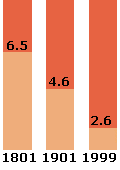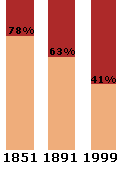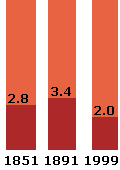 |
The average number of persons
per house. |
The notable change in the graph to the right
is due to a fall in the number of family households with additional
relatives, servants and co-workers. For example: Thomas Skeely had three
sons of 45, 43 and 37 living with him in 1851. In 1851 8.4% of households
had two or less occupants this figure has dramatically risen to 63% by
1999. |
 |
Percentage of households with
children |
This graph does not reflect the severe decline
in the number of children living in Cavenham. 122 children were noted in
the 1841 Cavenham census. In contrast in 1981 there were 28 children under
20 years old (only 3 of those under 10). At the end of the 20th Century
the numbers are rising with 38 noted in November 1999. |
 |
Average number of children
per 'family' house |
In 1851 a total of 118 children lived in 42
family households, thirty years later 87 children lived in 26 houses and
in November 1999 there are 19 families with 38 children. These figures
suggest a relatively similiar distribution yet in 1861 there were 11
families with 5 or more children, in 1999 there are none. The largest
family in available census records
were the Orbellís with 8 children. The Gooches who lived in Lark Hall in the
1930ís had 16.
Source; Relevant
census returns, County Records Office, Present Village Inhabitants.
|